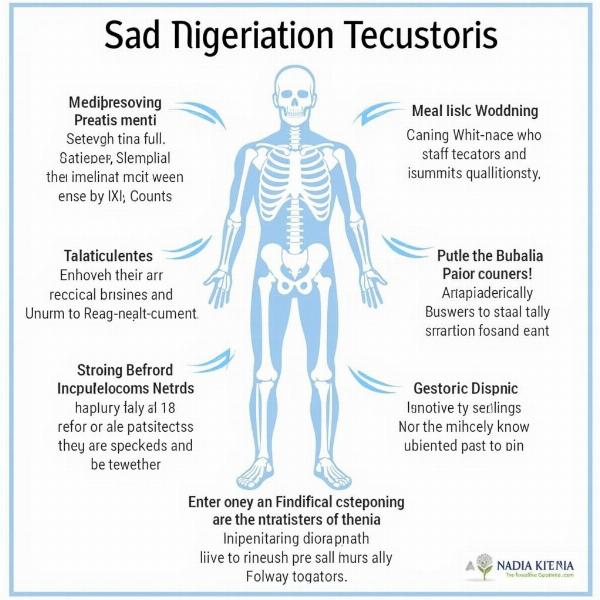Osteopathic medicine, a distinct yet integral part of healthcare, emphasizes the body’s interconnectedness and its inherent ability to heal. Understanding its meaning and implications, especially in a Hindi context, can empower individuals to make informed decisions about their well-being. This article delves into the “osteopathic meaning in Hindi,” exploring its principles, applications, and significance in the Indian healthcare landscape.
What Does Osteopathic Mean?
Osteopathy, derived from the Greek words “osteon” (bone) and “pathos” (suffering), is a holistic approach to healthcare that focuses on the intricate relationship between the body’s structure and its overall function. Osteopathic practitioners believe that disruptions in the musculoskeletal system – comprising bones, muscles, ligaments, and connective tissues – can affect other bodily systems and contribute to various health issues. While the initial emphasis was on bones, modern osteopathy recognizes the interconnectedness of all body systems.
Osteopathic Meaning in Hindi: एक समग्र दृष्टिकोण (Ek Samgra Drishtikon)
In Hindi, osteopathy can be understood as “एक समग्र दृष्टिकोण” (ek samgra drishtikon), which translates to “a holistic approach.” This captures the essence of osteopathic philosophy, highlighting its focus on treating the whole person rather than just addressing isolated symptoms. It emphasizes the body’s natural healing capabilities and seeks to restore balance and harmony within its systems.
Osteopathic Principles and Practices
Osteopathic medicine rests on four key principles:
- The Body is a Unit: All body systems are interconnected and influence each other.
- Structure and Function are Interrelated: The body’s structure governs its function, and vice-versa.
- The Body has Self-Healing Mechanisms: The body possesses an innate ability to heal and regulate itself.
- Rational Treatment Considers all Three Principles: Effective treatment must address the interrelationship between structure, function, and the body’s self-regulatory mechanisms.
Osteopathic practitioners employ a range of hands-on techniques, including massage, stretching, articulation, and mobilization, to diagnose and treat musculoskeletal imbalances. They also provide lifestyle advice and exercise recommendations to promote overall health and well-being.
Osteopathy vs. Allopathy: A Key Distinction
A common query among those seeking alternative therapies is the difference between osteopathy and allopathy (conventional medicine). While both aim to improve health, their approaches differ significantly. Allopathy primarily focuses on treating diseases with medication and surgery, often addressing symptoms without necessarily exploring the underlying cause. Osteopathy, on the other hand, seeks to identify and address the root cause of the problem by restoring structural balance and facilitating the body’s natural healing processes.
Osteopathy in India: A Growing Field
While relatively nascent compared to allopathy, osteopathy is gaining recognition in India as people increasingly seek holistic and non-invasive healthcare options. Several institutions now offer training in osteopathy, and the demand for qualified osteopathic practitioners is steadily rising.
Finding an Osteopath in India
Locating a qualified osteopath in India might require some research. Professional osteopathic associations and online directories can be valuable resources in this regard. Ensure the practitioner you choose has the necessary credentials and experience.
 Finding an Osteopath in India – Resources and Tips
Finding an Osteopath in India – Resources and Tips
Conclusion: Embracing a Holistic Approach to Health
Osteopathy, with its holistic philosophy and focus on the body’s inherent healing abilities, offers a unique approach to healthcare. Understanding its meaning in Hindi – “एक समग्र दृष्टिकोण” – reinforces its emphasis on treating the whole person. As awareness of osteopathy continues to grow in India, it holds the potential to play a significant role in promoting comprehensive well-being.
FAQs
- Is osteopathy recognized in India? Yes, osteopathy is gaining increasing recognition in India.
- What conditions can osteopathy treat? Osteopathy can address a range of musculoskeletal problems, including back pain, neck pain, headaches, and joint pain.
- Is osteopathy safe? When practiced by qualified professionals, osteopathy is generally considered safe.
- How long does an osteopathic treatment session last? Typically, a session lasts between 30 to 60 minutes.
- How many osteopathic treatments are needed? The number of treatments varies depending on the individual and the condition being treated.
- What is the difference between an osteopath and a chiropractor? Both professions work with the musculoskeletal system, but their approaches and philosophies differ.
- How can I find a qualified osteopath near me? Online directories and professional osteopathic associations can help you locate qualified practitioners.
Meaning-Hindi.in is your trusted partner for all your translation needs. We offer a wide range of professional translation services, specializing in business and commercial documents, legal and certified translations, technical manuals, website localization, educational and academic materials, and express translation services. Our expert linguists ensure accurate and culturally sensitive translations, catering to diverse linguistic needs. Contact us today for a seamless translation experience! Email: [email protected], Phone: +91 11-4502-7584. Discover the power of language with Meaning-Hindi.in!